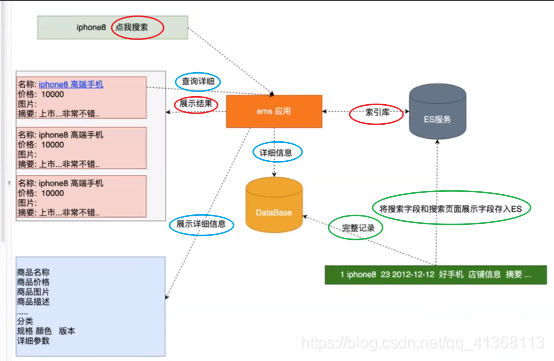一、项目环境
- 前端技术栈:BootStrap; Jqgrid
- 后端技术栈:Mybatis, SpringBoot-2.2.5.RELEASE
- 数据库:mySql; Redis
- 中间件:ElasticSearch-6.8.0; IK分词器
- 软体:jdk1.8; IntelliJ IDEA2019; Centos7虚拟机; MobaXterm; RDM; Kibana
二、文章主题
- 内容概述:为实现SpringCloud_Video项目,对ElasticSearch进行学习,本文是不良人_ElasticSearchP37~39小节项目的复现。
- 项目源码:videoProject01_pub : dev01
- 项目参考:不良人_ElasticSearch,不良人_BootStrap
- 功能展示:
(1) 后台(管理员侧)功能: 1) item词条分页展示; 2) 基于基础数据库重建ES索引库; 3) 清空ES中的文档; 4)添加/删除远程词典; 5) 全网热搜排行
(2) 前台(用户侧)功能: item词条检索并高亮展示。
三、文章内容
内容1:ElasticSearch注意事项
- ES支持Restful风格,是一种全文检索技术。ES中的重要概念:(1)索引(index);(2)类型(type);(3)映射(mapping);(4)文档(document)。
- 查看ES是否启动,可通过外部访问 http://xxx.xxx.xxx.xxx:9200,有值则成功。
- ES必须以普通用户身份安装(本文在虚拟机安装)。
- ES刚启动时不能外部访问远程链接。只能本机访问,需要开启远程链接权限。
- 需要以管理员用户身份安装Kibana客户端来操作ElasticSearch(本文在虚拟机安装),Kibana访问地址: http://xxx.xxx.xxx.xxx:5601/。
- ES默认的分词器只支持英文关键词检索,中文关键词检索会按一个字一个字检索。故需要在ES中加入IK分词器插件。(1)注意1:在线安装和本地安装IK分词器,config文件夹的位置不一样; (2)安装IK分词器时必须将ES中原始数据删除(进入ES安装目录中将data目录数据删除— rm -rf data)。
- ES集成java的实现原理如图1,2所示。


- ES集成SpringBoot的两种客户端操作:
(1) RestHighLevelClient:强大,灵活,但不能进行友好的对象操作,可用于检索关键词并高亮处理。
(2) ElasticSearchRepository: 对象操作友好(用到entity类),原理如图3所示。

内容2:项目主要功能代码说明
- 项目运行前提:(1) 开启ElasticSearch(xxx.xxx.xxx.xxx,普通用户身份);(2)开启redis(xxx.xxx.xxx.xxx,管理员用户身份);(3)开启kibana(xxx.xxx.xxx.xxx,管理员用户身份)。
- 配置ElasticSearch远程词典:
Step1: 在本机cmd上,输入ipconfig查看本机ip,
Step2: SpringBoot配置EditConfigures下的Working directory为 $MODULE_WORKING_DIR$
Step3: SpringBoot远程词典位置如图4所示

Step4: 启动springboot应用。
Step5: 虚拟机中ElasticSearch进行如下配置,配置完成后重启ElasticSearch:
vim elasticsearch-6.8.0/plugins/ik/config/IKAnalyzer.cfg.xml
# 而后配置如下:
<!DOCTYPE properties SYSTEM "http://java.sun.com/dtd/properties.dtd">
<properties>
<comment>IK Analyzer 扩展配置</comment>
<!--用户可以在这里配置自己的扩展字典 -->
<entry key="ext_dict"></entry>
<!--用户可以在这里配置自己的扩展停止词字典-->
<entry key="ext_stopwords"></entry>
<!--用户可以在这里配置远程扩展字典 -->
<entry key="remote_ext_dict">http://192.168.1.104:8989/mypoem/init.dic</entry>
<!--用户可以在这里配置远程扩展停止词字典-->
<entry key="remote_ext_stopwords"></entry>
</properties>
- 功能:“基于基础数据重建ES索引库”(借此说明ES与SpringBoot的整合)
Step1: 注意porm文件中,SpringBoot版本为2.2.5.RELEASE
Step2: 配置entity类
package com.salieri.entity;
import org.springframework.data.annotation.Id;
import org.springframework.data.elasticsearch.annotations.Document;
import org.springframework.data.elasticsearch.annotations.Field;
import org.springframework.data.elasticsearch.annotations.FieldType;
@Document(type = "poem", indexName = "poems")
public class Poem {
@Id
private String id;
@Field(analyzer = "ik_max_word", type = FieldType.Text)
private String name;
@Field(type = FieldType.Keyword)
private String author;
@Field(type = FieldType.Keyword)
private String type;
@Field(analyzer = "ik_max_word", type = FieldType.Text)
private String content;
@Field(type = FieldType.Keyword)
private String href;
@Field(analyzer = "ik_max_word", type = FieldType.Text)
private String authordes;
@Field(type = FieldType.Keyword)
private String origin;
@Field(type = FieldType.Nested)
private Category category = new Category();
...
}
=================================================================
package com.salieri.entity;
import org.springframework.data.elasticsearch.annotations.Field;
import org.springframework.data.elasticsearch.annotations.FieldType;
public class Category {
@Field(type=FieldType.Keyword, index=false)
private String id;
@Field(type=FieldType.Keyword)
private String name;
...
}
Step3: 配置SpirngBoot连接ES
新建com.salieri.config.RestClientConfig并进行如下配置:
package com.salieri.config;
import org.elasticsearch.client.RestHighLevelClient;
import org.springframework.beans.factory.annotation.Value;
import org.springframework.context.annotation.Bean;
import org.springframework.context.annotation.Configuration;
import org.springframework.data.elasticsearch.client.ClientConfiguration;
import org.springframework.data.elasticsearch.client.RestClients;
import org.springframework.data.elasticsearch.config.AbstractElasticsearchConfiguration;
@Configuration
public class RestClientConfig extends AbstractElasticsearchConfiguration {
@Value("${elasticsearch.rest.uri}")
private String uri;
//RestHighLevelClient dao PeomRepository
@Override
@Bean
public RestHighLevelClient elasticsearchClient() {
final ClientConfiguration clientConfiguration = ClientConfiguration.builder()
.connectedTo(uri)
.build();
return RestClients.create(clientConfiguration).rest();
}
}
Step4: 新建com.salieri.elastic.repository.PoemRepository并进行如下配置
package com.salieri.elastic.repository;
import com.salieri.entity.Poem;
import org.springframework.data.elasticsearch.repository.ElasticsearchRepository;
public interface PoemRepository extends ElasticsearchRepository<Poem,String> {
}
- 功能:“远程词典CRUD”
controller->DicController实现远程词典的CURD - 功能:“Redis热词统计“
Step1: 引入segment的jar包:
<!--segment-->
<dependency>
<groupId>com.github.houbb</groupId>
<artifactId>segment</artifactId>
<version>0.1.2</version>
</dependency>
segment的使用如图5所示:

Step2:引入redis的jar包
<!--redis-->
<dependency>
<groupId>org.springframework.boot</groupId>
<artifactId>spring-boot-starter-data-redis</artifactId>
</dependency>
Step3: 配置文件中配置redis:
spring.redis.host=192.168.94.140
spring.redis.port=7000
Step4: PoemController中的相关代码:
// 放入redis
if (!StringUtils.isEmpty(content)) {
// 对搜索进行分词处理
List<String> segment = SegmentHelper.segment(content, SegmentResultHandlers.word());
log.info("当前搜索分词结果为:[{}]",segment);
segment.forEach(word->{
if (word.length()>1) {
stringRedisTemplate.opsForZSet().incrementScore("keywords",word,0.5);
}
});
}
========================
// 获取redis热词排行榜
@RequestMapping("findRedisKeywords")
public Set<ZSetOperations.TypedTuple<String>> findRedisKeywords(){
Set<ZSetOperations.TypedTuple<String>> keywords = stringRedisTemplate.opsForZSet().reverseRangeWithScores("keywords", 0, 20);
return keywords;
}